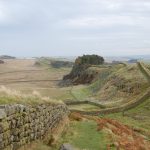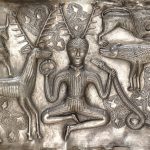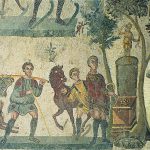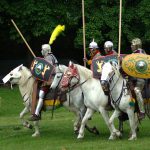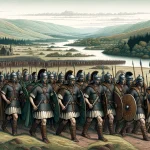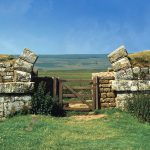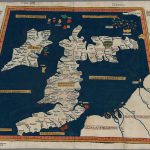Virosidum (Brough-by-Bainbridge) Fort
Flavian Auxiliary Fort (AD 69–96) and Minor Settlement
In outline the fort describes a regular parallelogram, with both the shorter east and west sides each about 270 feet (c.100 m) long internally, and the longer north and south sides both about 330 feet (c.82 m) in length, being parallel to each other. The acute north-east and south-west corners subtend an angle of about 85 degrees, while the obtuse north-west and south-east angles both measure about 95 degrees. The area thus enclosed is only about 2 acres (c.0.8 ha), which is rather small, and perhaps points to part of the garrison unit being stationed elsewhere. There are gateways set centrally in each of the four sides, and what appear to be titulum outworks defending both the northern and western entrances. The rampart was fronted by a double ditch system on all sides apart from the west, where there are a number of irregularly spaced defensive outworks, possibly the remains of an annexe. The fort was oriented towards the east. The original rampart was of packed clay on a cobble foundation, having a width of about 20 feet, probably faced with timber, surmounted by a wooden parapet and punctuated by wooden gateways. A stone revetment was added to the front of the rampart probably at the beginning of the third century (see below), and an annexe defined by a stone rampart-wall which appears to be attached to the fort’s defences on the east may also date to this period (Collingwood pp.38, 89 & fig.7 p.31; JRS 1953 p.88).
The fort of Brough-by-Bainbridge (Fig. 7), in Wensleydale, seems to belong to the same series [along with others at Slack, Ribchester and Elslack] of Flavian foundations in Brigantian country. it is about 330 by 270 feet internally, or 2 acres; and was at first defended by a clay rampart about 20 feet across, laid on a cobble foundation, with a wooden parapet and wooden gateways.[3 Proc. Leeds Philos. Soc., vol. I, part vi; vol. II, pt. ii.]” (Collingwood p.32)
The foundation date of the fort is not known with any certainty, but its general layout suggests that it is probably Flavian, and its location deep in Brigantian territory may indicate a connection with the Brigantian campaigns of Quintus Petillius Cerialis who was governor of Britain c.71-74AD. It is possible that the fragmentary inscription RIB 724 (not shown) may be dated to this initial period of occupation. Other building work is attested at the fort during the campaigns of the emperor Septimius Severus and his sons in the Scottish Lowlands at the beginning of the third century.
Virosidum – The Settlement of True Men
The only classical reference for the name of the fort at Brough by Bainbridge is the Notitia Dignitatum, which was produced towards the end of the fourth century. The fort is the very last one listed under the commands of the “Right Honourable Duke of the Britains”, and the entry is given in full below.
The Virosidum Entry in the Notitia Dignitatum
“The tribune of the Sixth Cohort of Nervii at Uirosidum.”
The placename Virosidum seems to be entirely Latin in formation, perhaps from the noun vir ‘man, male, true men’, and the verb sido ‘to settle down’, with the meaning ‘the settlement of true men’ – i.e. loyal to the emperor. If a Latin etymology is correct, it would indicate that the fort was founded on a virgin site, as the Romans were in the habit of adopting local names for their towns in particular, and, as one would expect for a Roman fort sited in the middle of nowhere from the legionary’s perspective, the place was given an entirely Roman name.
Other Epigraphic Evidence from Brough-by-Bainbridge
Building Inscription of Governor Gaius Valerius Pudens
“For Imperator Caesar Lucius Septimius Severus Pius Pertinax Augustus, and Imperator Caesar Marcus Aurelius Antoninus Pius Felix Augustus, and Publius Septimius Geta, Noble Caesar,¹ when our lords Imperator Antoninus for the second time and Geta Caesar were consuls,² under the administration of Gaius Valerius Pudens,³ the most distinguished of consulars, the centuries of the Sixth Cohort of Nervians made this under the command of Lucius Vinicius Pius, designated prefect of the same cohort.”
(JRS li (1961), p.192, no.4; also JRS lix (1969), p.246; Dated: c.202-205AD)
- The emperors Septimius Severus and his eldest son Caracalla, also his youngest son Geta.
- Caracalla held the consulship for the second time 205AD (a.u.c. 958), with his brother Geta as junior colleague.
- Gaius Valerius Pudens was governor of Britain from c.202/3AD until 205 or later.
Cohors Sextae Nerviorum – The Sixth Cohort of Nervii
In the early third century the rampart was strengthened by the addition of a stone revetment, the renovation work being undertaken by the Sixth Cohort of Nervians, a regiment of auxiliary infantry soldiers recruited from amongst the Nervii tribe of Belgica province. This unit is mentioned on three out of the five recorded inscriptions on stone, also in the Roman administrative document the Notitia Dignitatum (vide infra). Two of the inscriptions mention the same commanding officer, one Lucius Vinicius Pius. The first inscription is dated to the administration of governor Gaius Valerius Pudens, at which time his title is defined as PRAEF[ectus] COH[ortis] D[esignatus] or ‘Designated Prefect of the Cohort’ (vide JRS 1961.4 supra). He is entitled praefectus on the second stone, but there is a suggestion that this was still only a temporary command and his actual rank was that of military tribune in one of the British legions (vide RIB 722 infra).
RIB 722 - Imperial dedication to Septimius Severus, Caracalla, and Geta
For the Emperor Caesar Lucius Septimius Severus Pius Pertinax Augustus and for the Emperor Caesar Marcus Aurelius Antoninus Pius Felix Augustus and for Publius Septimius Geta, most noble Caesar, the Sixth Cohort of Nervians built this [rampart] of uncoursed masonry with annexe-wall under the charge of Lucius Alfenus Senecio, senator of consular rank Lucius Vinicius Pius, prefect of the same cohort …, had direction of the work.
PIO PERT[...]NACI AVGV[...]
IMP CAESARI M AVRELIO A[...]
PIO FELI[...] AVGVSTO ET P S⟦EPTIMIO⟧
⟦GETAE NOBILISSIMO CAESARI⟧ [...]
BRACCHIO CAEMENTICIVM [...]
VI NERVIO[...]M SVB CVRA L A[...]
SENECION[...] AMPLISSIMI [...]
OPERI L VIN[...]VS PIVS PR
The governorship of Alfenus Senecio dates to 205-(approx.) 208 (Birley in Askew Coinage 81, JRS 51 (1961) 192 no. 4). The text precedes the appointment of Geta as Augustus in A.D. 209.
RIB 723 - Inscription
For the Emperor Caesar Augustus … son of Marcus Aurelius … under the charge of Lucius Alfenus Senecio, of senatorial rank, … the Sixth Cohort of Nervians set this up, commanded by Lucius Vincius Pius, prefect of the said cohort.
MARCI AVRELII FILIO [...]
[... ...]
SEN[...]IONIS AMPLISSIMI [...]
[... ] VINIC[...] PIVS [...]
As the name of [L. Alfenus] Senecio, amplissimus vir can here be restored, the inscription can be dated to about 205-about 208 (cf. RIB 722).Birley and Richmond Arch. Ael. 4th Ser. xiii (1936) 225 n. 10 suggest that the Severan inscription had been reused as a flagstone in the fourth-century Headquarters Building, and that on it there had been placed a statue of Maximianus Herculius (Augustus A.D. 286-305).Huebner (Rh. Mus.) suggests that Camden gave a version of RIB 722 as a doublet; he rejects this in CIL. Addenda from RIB+add. (1995): For the date of Senecio’s governorship (probably 205-8) see Birley Fasti, 157-61.
Map References for Virosidvm
References for Virosidvm
- Chronicle of the Roman Emperors by Chris Scarre (Thames & Hudson, London, 1995);
- Chronology of the Ancient World by E.J. Bickerman (Thames & Hudson, London, 1980);
- The Roman Inscriptions of Britain by R.G. Collingwood and R.P. Wright (Oxford 1965);
- Air Reconnaissance of Southern Britain by J.K. St. Joseph in J.R.S. xliii (1953) pp.81-97;
- The Archaeology of Roman Britain by R.G. Collingwood (Methuen, London, 1930).
Map References for Virosidvm
NGRef: SD9390 OSMap: LR98
Roman Roads near Virosidvm
SW (24) to Calacvm (Burrow in Lonsdale, Lancashire) Possible road: E (8) to Wensley (North Yorkshire)
Sites near Virosidum (Brough-by-Bainbridge) Fort
- Wensley Roman Fort (14 km)
Flavian Auxiliary Fort (AD 69–96) - Scargill Moor Temples (21 km)
Temple Or Shrine - Bowes Moor Camp (22 km)
Marching or Temporary Camp - Rey Cross (Bowes) Marching Camp (23 km)
Marching or Temporary Camp - Bowes (Lavatris) Roman Fort (24 km)
Flavian Auxiliary Fort (AD 69–96) and Temple Or Shrine - Malham Marching Camp (25 km)
Marching or Temporary Camp - Bowes Temporary Camp (25 km)
Marching or Temporary Camp - Ingleborough Hillfort (25 km)
Iron Age Hillfort - North Stainmore Roman Signal Station (27 km)
Signal Station - Greta Bridge Roman Fort (27 km)
Trajanic Auxiliary Fort (A.D. 98–117)
